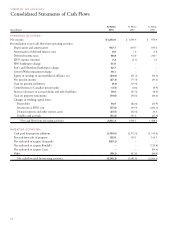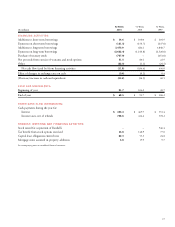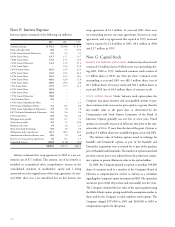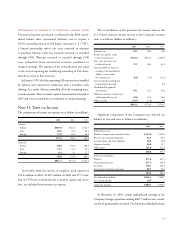Safeway 2001 Annual Report Download - page 28
Download and view the complete annual report
Please find page 28 of the 2001 Safeway annual report below. You can navigate through the pages in the report by either clicking on the pages listed below, or by using the keyword search tool below to find specific information within the annual report.
26
allowances and advertising allowances, mentioned above, and, to
a lesser extent, slotting allowances. Promotional and advertising
allowances are recognized as a reduction in cost of goods sold
when the related expense is incurred or the required performance
is completed. Safeway recognizes slotting allowances as a reduc-
tion in cost of goods sold when the product is first stocked,
which is generally the point at which all the related expenses
have been incurred. Lump-sum payments received for multi-year
contracts are amortized over the life of the contracts. Vendor
allowances did not materially impact the Company’s gross
profit in 2001, 2000 and 1999 because Safeway spends the
allowances received on pricing promotions, advertising expenses
and slotting expenses. Vendor allowances totaled $2.3 billion in
2001, $2.1 billion in 2000 and $1.7 billion in 1999.
USE OF ESTIMATES The preparation of financial statements in
conformity with generally accepted accounting principles requires
management to make estimates and assumptions that affect the
reported amounts of assets and liabilities and disclosure of con-
tingent assets and liabilities at the date of the financial statements,
and the reported amounts of revenues and expenses during the
reporting period. Actual results could differ from those estimates.
TRANSLATION OF FOREIGN CURRENCIES Assets and liabilities
of the Company’s Canadian subsidiaries and Casa Ley are trans-
lated into U.S. dollars at year-end rates of exchange, and income
and expenses are translated at average rates during the year.
Adjustments resulting from translating financial statements into
U.S. dollars are reported, net of applicable income taxes, as a
separate component of comprehensive income in the consolidat-
ed statements of stockholders’ equity.
CASH AND CASH EQUIVALENTS Short-term investments with
original maturities of less than three months are considered to be
cash equivalents.
MERCHANDISE INVENTORIES Merchandise inventory of $1,906
million at year-end 2001 and $1,846 million at year-end 2000
is valued at the lower of cost on a last-in, first-out (“LIFO”)
basis or market value. Such LIFO inventory had a replacement
or current cost of $1,989 million at year-end 2001 and $1,926
million at year-end 2000. Liquidations of LIFO layers did not
have a significant effect on the results of operations. All remain-
ing inventory is valued at the lower of cost on a first-in, first-out
(“FIFO”) basis or market value. The FIFO cost of inventory
approximates replacement or current cost.
PROPERTY AND DEPRECIATION Property is stated at cost.
Depreciation expense on buildings and equipment is computed
on the straight-line method using the following lives:
Stores and other buildings 7 to 40 years
Fixtures and equipment 3 to 15 years
Property under capital leases and leasehold improvements are
amortized on a straight-line basis over the shorter of the remain-
ing terms of the lease or the estimated useful lives of the assets.
SELF-INSURANCE The Company is primarily self-insured for
workers’ compensation, automobile and general liability costs.
The self-insurance liability is determined actuarially, based on
claims filed and an estimate of claims incurred but not yet
reported. The present value of such claims was calculated using
a discount rate of 5.0% in 2001 and 6.0% in 2000. The current
portion of the self-insurance liability of $102.1 million at year-
end 2001 and $103.4 million at year-end 2000 is included in
other accrued liabilities in the consolidated balance sheets. The
long-term portion of $218.3 million at year-end 2001 and $195.7
million at year-end 2000 is included in accrued claims and other
liabilities. The Company recorded expense relating to claims of
$149.1 in 2001, $84.7 in 2000 and $58.5 in 1999. Claims pay-
ments were $139.8 million in 2001, $132.0 million in 2000 and
$123.6 million in 1999. The self-insurance liability increased by
$12.0 million in 2001 because of the Genuardi’s Acquisition and
$38.7 million in 1999 because of the Randall’s and Carrs
Acquisitions. The total undiscounted liability was $366.6 mil-
lion at year-end 2001 and $352.2 million at year-end 2000.
INCOME TAXES The Company provides a deferred tax expense
or benefit equal to the change in the deferred tax liability during
the year in accordance with Statement of Financial Accounting
























